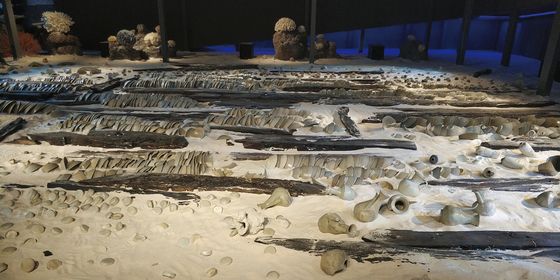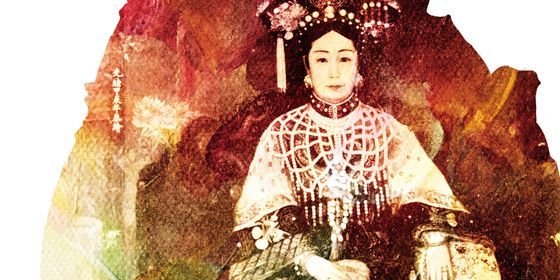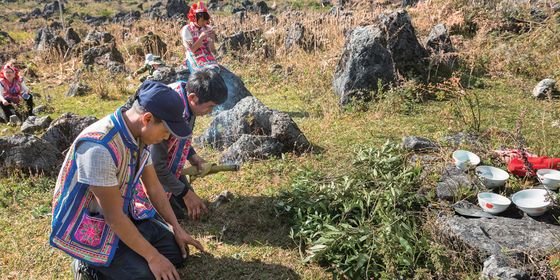A small Shandong city preserves the legacy of its most famous son
A baby born on September 28, 551 BCE, transformed the landscape of Chinese society. His father, Kong He, was a low-level member of the aristocracy, and the Kong family had fallen far from its previous position of privilege in the Shang dynasty (1600 – 1046 BCE). When the young boy was 3 years old, his father died—leaving his mother, Yan Zhengzai, to raise him in poverty.
This child went on to become China’s “First Sage” and given the title “Kongzi” (孔子). Jesuit missionaries later Romanized his name to “Confucius.”
From one dynasty to the next, Confucius became more myth than man. In a series of Ming dynasty (1368 – 1644) paintings exhibited at the Confucius Temple (孔庙) in Qufu, quite a different birth story is proffered: The god of Nishan Hill (尼山) listened to the prayers of Confucius’s parents and gave them a son; a qilin (a mythical hybrid of a dragon, ox, deer, and fish) declared Confucius an “uncrowned king”; and dragons and immortals hovered in the air over the family’s courtyard to witness the baby’s birth.
Though Confucius defined the course of Chinese society for the last two millennia, Confucian scholars are still debating if his beliefs count as a life philosophy or a religion. Due to this mix of lore and reality, following in the footsteps of this master can be a bit tricky, but there is no better place to begin than in his hometown of Qufu (曲阜).
Qufu has developed a worldwide reputation by basking in the glory of its most famous resident. Pilgrims from across Asia come to the city of 640,000 inhabitants to pay their respects to the great scholar. There are a number of ways to experience Qufu—from the five-star Shangri-la Hotel to budget-friendly youth hostels.
The historic city is now surrounded by a newly constructed wall and moat to resemble the one that protected the city during the Ming dynasty. Many of the gates include the historical barbican, or “jar wall” (wengcheng, 瓮城). If enemies stormed it, they would find themselves within an enclosed space where the defenders would rain down arrows from above. To the North, there’s the Drum Tower Gate (鼓楼门); in the city’s center is the bell tower. Used to keep the time during ancient China, the bell tower rang in the daylight hours, while the drum tower beat at night.

Old city wall from the Ming dynasty, Qufu
The city is full of small shops, markets, and street food vendors. The night market on the corner of Wumaci Street and Gulou South Street is great for sampling local Shandong dishes. The pedestrian Queli Street hosts a bustling street market where anything Confucius-related can be purchased.
The largest attractions of Qufu are the “San Kong” (三孔), the three UNESCO Confucius sites. A ticket can be purchased for 150 RMB per person at the Confucius Temple, which includes access to the Confucius Temple, the Confucius Mansion (孔府), and the Confucius Cemetery (孔林).
The Confucius Temple is said to have been built on the location of Confucius’s original house. Quite a few of the temple’s features are believed to have been preserved, including the famous Apricot Altar (杏坛), where Confucius taught his disciples. For centuries his abode was untouched—until China’s emperors decided that they needed to honor the great sage. Over the next two millennia, Confucius’s humble house was transformed and renovated into a huge 466-room complex, becoming China’s second-largest surviving ancient complex after Beijing’s Forbidden City.
The focal point is Dacheng Hall (大成殿). Built in 1724, at 32 meters tall, it is where sacrifices to Confucius are proffered. The hall is also supported by unique, stone-carved dragon pillars.
One can watch the daily opening ceremony of the Confucius Temple at 8 a.m. by the South Gate. The celebration of Confucius’s birthday on September 28 also coincides with a two-week International Confucian Culture Festival (国际孔子文化节), which provides learning opportunities for both Confucian novices and scholars.
Confucius was not always beloved throughout Chinese history. Confucius’s descendants were forced to hide his books to protect them from the persecution of Qin Shi Huang, the first emperor to unite China. In the infamous “Burning of the Books” in 212 BCE, the emperor demanded that all Confucian classics be burnt, and some 460 scholars may have been buried alive.
During the Song and Ming dynasties, the Kong family was given a massive mansion, right next to the Confucius Temple. It reached its present size during the Qing dynasty (1644 – 1911) at an impressive 70,000 square meters and 480 rooms.
Not only a residence, the mansion was also the place of official business for the Duke of Yansheng (衍圣公). The Duke was tasked with protecting the Confucius Temple and offering the appropriate sacrifices. Over time, his powers expanded. At his height, the Duke of Yansheng had de facto power to rule over Qufu and the surrounding areas.
The first halls of the house were set aside for government administration and the business of the Duke of Yansheng. The back of the house comprises the traditional residences of the Kong family, as well as an intricate garden, which includes a peony garden, bamboo forest, and Iron Hill. The Confucius Family Mansion hosts daily Peking opera and music shows in one of the garden’s pavilions.
The last of the “San Kong” sites is located outside of the city walls, about a 30-minute walk from the rest of the Confucius complexes. Walking along this road, visitors encounter one wood-carving workshop after another. Many are filled with wooden sculptures of Confucius, but they are also stuffed with one of Qufu’s “Three Treasures”: wood-carved ruyi (如意), a curved decorative object symbolizing good fortune.
Elites have always prized ruyi. Qufu’s ruyi are made from Chinese pistache trees. When Confucius died, one of his disciples, Zigong (子贡), is said to have lived by Confucius’s grave for six years. He placed a stick into the ground, which, miraculously, became China’s first pistache tree. He carved a figure of Confucius from the wood, prompting the city’s unique wood carving industry. Qufu’s ruyi are carved with Confucius’s image or with stories and legends from Shandong province, such as the Eight Immortals Crossing the Sea.
The Confucius Cemetery is also known as the Kong Family Forest. A bevy of elderly people can be found inside the entrance, eager to give you a tour (for a fee). While not necessary, these guides can provide insights into life in Qufu.
Over 100,000 of Confucius’s descendants are estimated to have been buried in the Confucius Cemetery, with burials still occurring daily. Because of overcrowding, they now only allow the ashes of cremated Confucius descendants to be buried. The tombs are denoted sometimes by gravestones and also by small hills. It is a peaceful place, full of some 42,000 ancient trees. There is a waterway going through the cemetery, which some locals believe was dug by China’s first emperor, Qin Shi Huang, to disrupt the spirits in the cemetery. The waterway fits in beautifully with the rest of the cemetery and is in accordance with traditional feng shui concepts.
Located in the center of the Confucius Cemetery, the Tomb of Confucius is a large hill, in front of which stands a large stone tablet. To the right of his tomb lies the tomb of Kong Li, his son, who died before his father. In front of Confucius’s tomb is the tomb of Kong Ji, his grandson, who was rumored to be the teacher of Mencius, the “Second Sage.”
The legacy of Confucius lives on in the San Kong, as well as in a plethora of sites throughout the small city. One is the Yanmiao Temple (颜庙), and the Pavilion of Joy (乐亭), which was rebuilt during the Ming dynasty on the residence of Yan Hui (颜回), Confucius’s most favored disciple. It is coupled with a saying from Confucius, which describes how Yan’s relatively austere life circumstances never took away from his joy.
The Temple of the Duke of Zhou (周公庙), built during the Song dynasty (960 – 1279) is worth a visit. A legendary man during the Zhou dynasty (1046 – 256 BCE), Confucius sought to emulate the Duke of Zhou’s reign as a model for other Chinese princes. Visitors should also take the opportunity to see the legendary Nishan Hill, the birthplace of Confucius. The mountain boasts a temple and the world’s tallest statue of Confucius, standing at 72 meters.
The Six Arts of Confucius
The goal for Confucians in ancient China was to become a junzi (君子), or “superior man.” A proper junzi should be loyal to one’s ruler, filial to one’s parents, and honest. The word junzi was mentioned no less than 107 times in Confucius’s Analects (《论语》 ). Students were encouraged to become junzi by mastering the “six arts” of ancient Chinese education:

Today, people seeking to master the “six arts” can visit the Confucius Six Arts City (孔子六艺城) in Qufu. While the theme park may be difficult for foreigners to navigate, it does put on shows twice per day. There is also an archery range, a “charioteering” cart rides depicting the life of Confucius through wax figurines, as well as a replica model of what Qufu would have looked like during Confucius’s days, complete with street vendors. Tickets are 60 RMB and it is advised to hire one of the tour guides to explain the attractions.
Cover image: Nishan Hill, Jining
Excerpt taken from Rivers Deep, Mountain High, TWOC’s guide to Shandong. Get your copy today from our online store!













